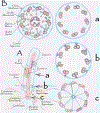Cilia Structure and Function in Human Disease
- PMID: 38836197
- PMCID: PMC11147146
- DOI: 10.1016/j.coemr.2024.100509
Cilia Structure and Function in Human Disease
Abstract
Ciliary dysfunction causes a large group of developmental and degenerative human diseases known as ciliopathies. These diseases reflect the critical roles that cilia play in sensing the environment and in force generation for motility. Sensory functions include our senses of vision and olfaction. In addition, primary and motile cilia throughout our body monitor the environment allowing cells to coordinate their biology with the cells around them. This coordination is critical to organ development and maintenance, and ciliary dysfunction causes diverse structural birth defects and degenerative diseases. Defects in motility cause lung disease due to the failure of mucociliary clearance, male infertility due to the failure of sperm motility and the ability of sperm to move through the efferent ducts, and disturbances of the left-right axis due to a failure of nodal cilia to establish proper left-right cues.
Conflict of interest statement
Declarations of interest: none.
Figures


References
-
- Afzelius BA 1976. A human syndrome caused by immotile cilia. Science. 193:317–319. 10.1126/science.1084576. - DOI - PubMed
-
** Electron microscopy identified defects in respiratory cilia from patients with Kartagener’s syndrome, now known as Primary Ciliary Dyskinesia. This was the first ciliopathy identified.
-
- Alieva I, Staub C, Uzbekova S, and Uzbekov R. 2018. A question of flagella origin for spermatids; mother or daughter centriole? Uzbekov RE, editor. Nova Science Publishers, New York. 109–121.
-
- Aprea I, Nothe-Menchen T, Dougherty GW, Raidt J, Loges NT, Kaiser T, Wallmeier J, Olbrich H, Strunker T, Kliesch S, Pennekamp P, and Omran H. 2021. Motility of efferent duct cilia aids passage of sperm cells through the male reproductive system. Mol Hum Reprod. 27. 10.1093/molehr/gaab009. - DOI - PMC - PubMed
Grants and funding
LinkOut - more resources
Full Text Sources
